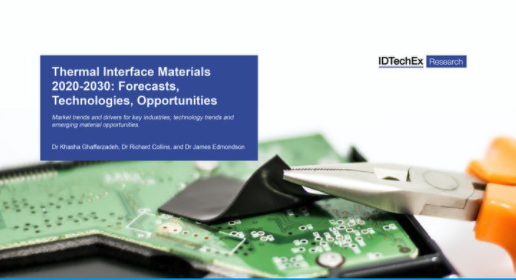
Smartphone thermal management materials: what’s new, what’s next?
By Dr Richard Collins, principal analyst at IDTechEx, Cambridge, UK
Electronics Production / Materials management materials smartphone thermalRise of 5G-enabled smartphones makes this more challenging than ever
Thermal management is one of the most important considerations for all consumer electronics. Any teardown quickly demonstrates the extensive consideration engineers take to dissipate heat effectively. The rise of 5G-enabled smartphones makes this more challenging than ever, resulting in significant design alterations and the adoption of advanced materials.

Source: IDTechEx
What is meant by a thermal management materials
Thermal management materials are primarily those that enable the heat to be dissipated strategically and evenly (mitigating hot spots). These can broadly be split into heat spreaders, mainly for x-y or in-plane dissipation, and thermal interface materials (TIM), mainly for z or through-plane dissipation. Both are essential and work in tangent for various application areas.
IDTechEx has identified six primary locations for these materials in a smartphone: heat spreader at the back of the phone, heat spreader for the central motherboard, TIM for the lithium-ion battery, TIM for motherboard (e.g., PMICs), heat spreader behind the display, and TIM for the antenna. All of which will have their own requirements and considerations.
The key property is the thermal conductivity, in either the x-y or z-plane, but it is essential to not overlook many other factors including: adhesiveness, viscosity, coefficient of thermal expansion (CTE), bond line thickness, re-workability, and longevity.
How will 5G smartphones be different?
As many will know, when an electronic device is struggling with the temperature it will throttle the performance. For 5G phones this will effectively mean disabling some of the 5G capabilities, taking your smartphone back a generation or two.
At the device level, the main changes to thermal management materials will be around the motherboard and the antenna. This is somewhat obvious for the motherboard, with significantly increased download rates enabled by 5G, and the key antenna changes will be for mmWave applications. There will, of course, be the same trends in batteries, displays, and performance for smartphones as has been observed across the past decade for engineers to contend with.
Will vapour chambers be the new norm?
One option is to use a vapor chamber or heat pipe instead of a graphitic heat spreader for the motherboard. These have been widely advertised by the likes of Samsung and there are undoubtedly performance advantages, but also with many trade-offs. The jury is still out as to whether this will become prevalent across phones.
Which advanced materials can help with heat dissipation?
As discussed, there are numerous thermal management considerations. As a result, engineers are starting to look at some early-stage material developments to provide those necessary properties.
Two specific smartphone examples can be highlighted, Huawei’s use of a graphene-based heat spreader in their latest devices and Samsung’s use of a TIM with carbon fiber conductive filler. There is a huge amount of innovation going into next-generation TIM materials.
Why are insulators important?
This article has talked exclusively about thermal dissipation, so why would it now switch to thermal insulation; the reason is skin temperature. With more and more demanding components within consumer electronic devices, and a need to keep size and weight to a minimum, it can be necessary to introduce high-performance insulators to control the surface temperature and channel the heat elsewhere. An air gap will often be suitable, but where this is not possible alternative solutions must be sought. High-performance insulators, in conjunction with heat spreaders, are becoming more prevalent in this field.
Most notable was W.L. Gore & Associates use of silica aerogel particles for certain Dell laptops, and Gore has again provided an advanced solution specifically for mmWave 5G antennas. Aerogels are just one solution, offering a thermal conductivity lower than that of stationary air.
The 5G landscape is moving quickly and thermal management considerations cannot be overlooked. There are many competing strategies tackling these universal demands and a large market opportunity for materials companies that can provide the best performing and most economical solution.
————————
For more information on 5G, thermal management, advanced materials, and more visit www.IDTechEx.com/Research.
